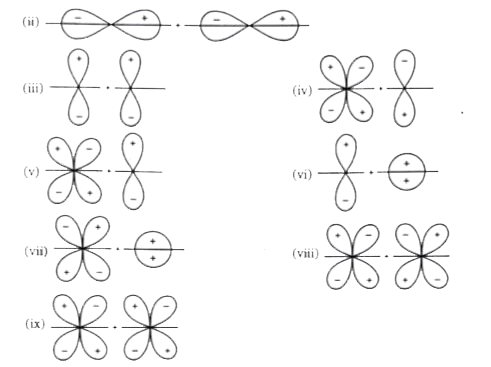There are some arrangements of atomic orbitals which are given below:

 Then calculate the value of "QtimesR-P'" where P, Q and R are no. of arrangements which give bonding molecular orbitals (positive overlap), antibonding molecular orbitals (negative overlap) and non-bonding molecular orbitals (zero overlap) respectively.
Then calculate the value of "QtimesR-P'" where P, Q and R are no. of arrangements which give bonding molecular orbitals (positive overlap), antibonding molecular orbitals (negative overlap) and non-bonding molecular orbitals (zero overlap) respectively.
Text Solution
The correct Answer is:2
(P)=(i), (iii), (Iv), (vii), (4)
(Q)=(ii), (v), (ix), (3)
(R)=(ii), (vii), (2)
then Q×R=3×2−4⇒2
|
Topper's Solved these Questions
Similar Questions
Knowledge Check
The strength of bonds by overlapping of atomic orbitals is in order
As−s>s−p>p−pBs−s>s−p>s−pCs−p>s−s>p−pDp−p>s−s>s−pA bonding molecular orbital always possesses lower energy than either of the atomic orbitals that have overlapped to from it because
Aelectrons placed in a bonding molecular orbital tend to hold the nucleus together and stabilise a moleculeBelectrons placed in a bonding molecular orbital repels each otherCthe electrons density in a bonding molecular orbital is located between the nuclei of the bonded atoms because of which the repulsion between the nuclei is very lessDBoth (1) and (2)
How is bonding molecular orbital of hydrogen different from the antibonding molecular orbital ?
View SolutionWhich type of atomic orbitals can overlap to from molecular orbitals ?
View SolutionWhich type of atomic orbitals can overlap to from molecular orbitals ?
View SolutionThe strength of bonds by overlapping of atomic orbitals is in order
View SolutionWhat orbitals can overlap to form a σ-bond and which orbitals can overlap to form a π-bond?
View SolutionWhat orbitals can overlap to form a σ-bond and which orbitals can overlap to form a π-bond?
View Solution
